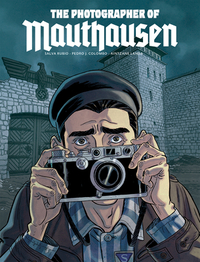Take a photo of a barcode or cover
adventurous
dark
emotional
sad
tense
fast-paced
We know of a place called Auschwitz, one of the six camps created by the Nazis purely for the purpose of extermination. Dachau outside Munich was the first mass internment camp. You see, the Nazis were the perfect definition of “method to madness”. There were various types of camps and sub-camps, filled largely based on the fate that awaited their occupants.
Mauthausen in Upper Austria was a camp where extermination through labour was the preferred method of murder. Unlike other camps, it was also home largely to the intelligentsia.
Among the prisoners at Mauthausen was an engineer called Simon Wiesenthal, who would make a name for himself hunting down Nazis in the post-War world. A lesser-known prisoner was the Spaniard Francesc Boix, a Communist who had been forced to flee his homeland after Franco’s victory and had taken refuge in France, which soon fell into German hands. It is Boix’s story that the comic The Photographer of Mauthausen seeks to tell.
Boix was a photographer during the Spanish Civil War and at Mauthausen, he was put to work developing photographs of the camp and the events taking place inside it for the Nazis. Boix would, in his time at the lab in Mauthausen, be a pivotal part of the smuggling out of three thousand negatives detailing the horrors of the camp.
The comic is well-written, in particular the second scene where the reader accompanies Boix to the camp, and covers all parts of Boix’s life at and just after Mauthausen in a manner that is compelling, while still doing justice and being respectful of the fact that it is, at the end of the day, about a person’s life in a concentration camp. What I didn’t like was the opening, nor the attempt of writer Salva Rubio to draw us emotionally closer to Boix through his desire to reunite with his sister. It felt clumsy. The narrative also doesn’t really give you a sense of time (Boix was imprisoned for four years) apart from just drop dates here and there.
Much of the flow of the comic is thanks to illustrator Pedro J. Colombo and colourist Aintzaine Landa, whose panels are to be marvelled at. The format is naturally dependent on their skill, and they shine through. Colombo is especially terrific in his recreation of Mauthausen and his depiction of faces, though I do wonder why he didn’t take greater care to portray the fatigue of the camps over a period of time. Landa’s distinct palettes in depicting the world of the camp and that which is outside it also stand out. Cold greys and murky browns fill page upon page, and the sudden appearance of a bright green or a pleasant yellow is as much a stylistic choice as one of appreciating just what the camps were.
The Photographer of Mauthausen stumbles along the way but does a fair job in telling the story of Francesc Boix. The greater win here is how it succeeds in making part of the Holocaust accessible without trying to alter history.
I was able to view a copy of the book thanks to NetGalley and the publishers Dead Reckoning in exchange for a review.
This graphic novel tells the story of Francisco Boix, a Spanish press photographer and communist who was sent to the Mauthausen concentration camp and found himself the confidant of an SS officer who was photographing thousands of prisoner deaths. He sees this as an opportunity to prove the horrific Nazi war crimes by stealing the negatives of these photos and exposing them to the World, at the risk of his own life and that of every other prisoner in the camp.
The depths of human strength and resilience never cease to amaze me. These things should never have happened and the majority of us will never truly understand them, but it is precisely by continuing to share these stories that we can stay alert to the horrors and perversity that people can impose on others, and prevent them from happening.
I breezed through this book and adored the art style as well. I highly recommend it to anyone.
Thank you to NetGalley and the publisher for providing a copy of this book in exchange for an honest review. All opinions are my own.
The depths of human strength and resilience never cease to amaze me. These things should never have happened and the majority of us will never truly understand them, but it is precisely by continuing to share these stories that we can stay alert to the horrors and perversity that people can impose on others, and prevent them from happening.
I breezed through this book and adored the art style as well. I highly recommend it to anyone.
Thank you to NetGalley and the publisher for providing a copy of this book in exchange for an honest review. All opinions are my own.
A heartbreaking, yet educational graphic novel about the Spaniards in the Nazi concentration camps during World War II. One brave Spaniard set out on a mission to photograph the Nazi's and find a way to get those pictures out into the world. This GN did not shy away from discussing the gruesome acts of the Nazi's and what the prisoners dealt with on a day to day basis. The illustrations were stunning, and the dark and gritty imaged tied the story together. I feel like this would be a great addition to high school library shelves.
I have received a much appreciated digital copy of this book from NetGalley and the publisher in exchange for an honest review.
I have received a much appreciated digital copy of this book from NetGalley and the publisher in exchange for an honest review.
This is an outstanding graphic novel about the power of testimony and the forms that testimony can take. Crafted with detail and attention and compellingly written, this book is an important contribution to literature about resistance and organization in WWII concentration camps, as well as an illustration on the need for historical accuracy, evidence, and documentation. This should not only be very well-received among regular graphic novel readers, but also those interested in WWII, the history of photography and journalism, and current activism. There's some swearing and of course images of the atrocities of Mauthausen, but I'd recommend this nonetheless for readers ages 12 and up. I'd love to see it taught in schools and chosen by book clubs for meaningful discussion.




